WHO’S AT FAULT IN FLORIDA?
GET A FREE LEGAL CONSULTATION
If you or a loved one has been injured in a car accident, determining who is at fault can be crucial to obtaining compensation for damages and injuries. A T-bone accident is no different. How the fault is assigned following a T-bone accident will have a major impact on your level of liability for damages and any remuneration you may receive.
But how exactly is fault determined after a T-bone car accident? The way in which fault is determined after any car accident can depend on many factors, such as:
- Who had the right of way?
- Were any of the drivers involved negligent in their actions?
- What state did the accident take place in?
Car accident victims have a better chance at a successful injury claim when they understand how fault is determined after a collision. A car accident attorney can also help victims after a crash. Car accident lawyers know the state laws surrounding car accidents and will work to get full compensation for their clients. Let’s take a closer look at how fault is determined after a T-bone car accident in Florida.
WHAT IS A T-BONE ACCIDENT?
A T-bone car accident occurs when the front end of a vehicle crashes into the side of a vehicle driving in a perpendicular direction forming a “T” shape. You may also hear this type of collision referred to as a side-impact collision or a broadside accident.
T-bone accidents are common and usually occur at an intersection. Regardless of the cause or location of the accident, a T-bone accident can cause serious injury, and in extreme cases, wrongful death.
The cost of being injured in a T-bone collision can really add up when you stop and think about it. Victims can suffer financial damages including:
- Medical bills
- Future treatment if needed
- Property damage
- Lost wages
- Permanent disability preventing work
This is why determining fault after an accident is so important. Victims could be left with some or all of the expenses if they are unable to prove they were not at fault in an accident.
FLORIDA IS A NO-FAULT STATE
The first thing to understand when determining fault in Florida is that Florida is a no-fault state. Florida statutes require that all drivers carry personal injury protection (PIP) coverage of $10,000. This means that your PIP policy will cover your injury expenses after an accident up to $10,000 regardless of who was at fault.
The problem is that broadside accidents can cause serious injuries that can easily exceed $10,000 in medical expenses. Determining fault is crucial in this case, especially if you were not responsible for the accident. Victims in such an accident can file a lawsuit against the other driver or their insurance provider for any damages that exceed what is covered by their PIP policy.
HOW IS FAULT DETERMINED IN A T-BONE ACCIDENT?
When trying to decide fault in a car accident, investigators will look to see what was the initial cause of the accident. Was the accident due to negligent action by either driver, vehicle malfunction, or caused by another vehicle?
If the accident was caused because of a mechanical malfunction, the vehicle manufacturer can sometimes be held liable for the accident. In other cases, a driver that avoided the collision may have caused the crash. The driver that was in the wrong and set off the chain of events leading to the accident would be at fault for such a collision.
However, most car accidents are usually caused by negligent action on the part of one or more of the drivers involved. Investigators must weigh the evidence of the scene against witness and driver statements to determine how the accident was caused and who truly had the right of way.
The four key factors to look at when determining if a driver was responsible for an accident are:
- Duty of Care: The at-fault driver had a duty of care to the other vehicle or vehicles in the accident.
- Negligence: There was a breach of the responsible driver’s duty of care leading to the collision.
- Cause: The negligent or purposeful actions of the at-fault driver caused the accident.
- Damages: There was injury, financial loss, or other damage suffered by the victim.
When both drivers are at fault, they will each be assigned a certain percentage of liability for the accident.
COMMON CAUSES FOR T-BONE ACCIDENTS
As we have learned, T-bone crashes are caused by a vehicle driving into the side of another parked or moving vehicle. These types of accidents take place most frequently at intersections where vehicles are crossing in perpendicular directions. This is usually a result of the at-fault driver failing to yield the right of way but can be caused by a number of different circumstances.
Some of the more common reasons T-bone accidents occur include:

RUNNING A RED LIGHT
Anytime a driver runs a red light, they have a chance of causing a T-bone accident. This can be an extremely dangerous type of accident because both drivers involved are usually driving at the posted speed limit for the intersection. A T-bone accident when a driver runs a red light at high speeds can spell disaster for any driver or passenger on the side of the vehicle which takes the brunt of the impact.

RUNNING A STOP SIGN
Running a stop sign can be just as dangerous as running a red light. Fortunately, these accidents are not as common at a four-way stop as they are at a stoplight intersection. A four-way stop requires all parties to stop. This allows other drivers a better chance to identify and avoid a potential accident, even if they had the right of way.
T-bone collisions are more commonly caused when a driver runs a stop sign at an intersection where the adjoining road does not have a traffic control device. The fault will almost always lie with the driver that had the stop sign in such an accident.

LEFT-TURN ACCIDENTS
Another common cause for T-bone accidents is left-turn accidents. A left-turn accident occurs when a driver is making a left turn and is either hit by a driver moving the opposite direction or hits a driver moving the opposite direction. These accidents can sometimes present a harder challenge in determining fault as both drivers have the potential to be at fault.
The driver making the turn can be at fault if they make a left turn too soon, leaving the other driver no time to avoid the collision. The driver not making the turn can also cause a T-bone crash if they failed to slow down to avoid the accident when they could have or if they ran a red light or stop sign.
MAKING A DANGEROUS U-TURN
A U-turn at an intersection can cause a T-bone accident in the same way that a left turn can. The driver making a U-turn must identify any oncoming traffic and yield to them before making their turn. Accidents usually occur when the driver making the U-turn does not see an oncoming car before they turn. The fault would land with the driver making the turn in such a situation.
EXITING A PARKING LOT ONTO THE STREET
Side-impact collisions that do not take place at an intersection are commonly caused when cars are exiting a parking lot onto the street. The driver exiting a parking lot onto the street has a duty of care to check that the road is clear before pulling out. If the driver is crossing the street to make a left turn, they must ensure that both sides of the road are clear of traffic before crossing the road.
INJURIES FREQUENTLY SEEN AFTER T-BONE ACCIDENTS
The nature of a T-bone accident can lead to serious or even fatal injuries, especially for the driver or passengers of the vehicle hit in the side. Cars are designed to absorb greater impacts in the front and rear. This means impacts to the side of a car can cause more damage to the cabin and the people therein.
The severity of injuries for anyone in the vehicle struck in the side will depend on which side was hit. If the driver’s side of the vehicle was impacted, the driver and a passenger on that side of the vehicle are much more likely to have sustained serious injuries.
Injuries that are often seen following a side-impact crash include:
- Broken or fractured bones
- Traumatic brain injuries, concussions, migraines, or headaches
- Muscle, tendon, and ligament injuries
- Lacerations
- Paralysis
These types of injuries may require expensive medical treatment and long-term care. Some injuries may even alter your ability to earn money or enjoy life. A car accident lawyer can help make sure you are compensated for the damages such an accident can cause.
HOW CAN A CAR ACCIDENT LAWYER HELP?
Understanding the laws that govern car accidents and injury claims is important for anyone looking to file an injury claim or prove fault after a T-bone accident. However, the average person does not have exceptional working knowledge of these particular laws. This is where hiring a car accident attorney can truly benefit you.
Experienced car accident lawyers offer their clients a wealth of knowledge regarding how to pursue an injury claim and how to deal with insurance companies. Lawyers can also help clients gather the right evidence needed to prove fault after an accident.
Evidence will play a crucial part in reaching a successful outcome with your claim. Be sure to gather as much evidence at the scene of the collision as you can unless you need immediate medical attention. Look to gather things, such as:
- Photos of the scene, damages, and injuries
- Witness statements
- Insurance and contact information from the other driver
- Contact information from any witnesses or first responders
- Police statements
This information provides ammo for your attorney to help you win your case. Additionally, your attorney will perform their own in-depth investigation into the accident to learn all the pertinent facts. A car accident lawyer can help you obtain: - Police and witness statements
- Any video footage of the accident from a nearby business, security, or traffic cameras
- Medical documentation to support your injury claims
Victims have nothing to lose by talking with a car accident lawyer about their case. Victims can schedule a free consultation with an attorney to discuss their claim before hiring them. The initial consultation can help victims understand their legal rights, whether or not they have a strong case, and how best to proceed from here.
